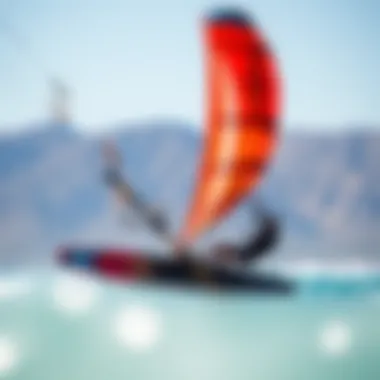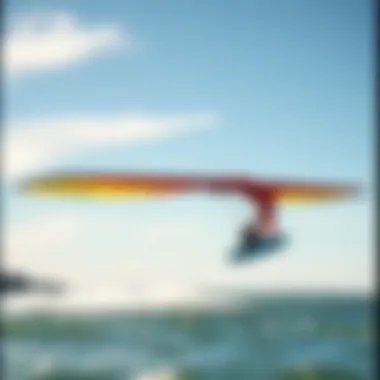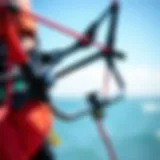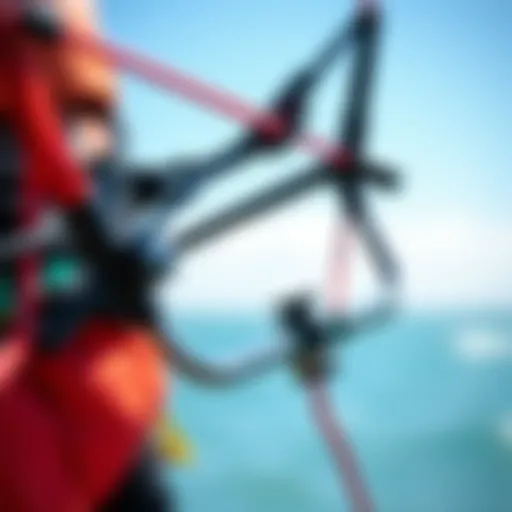Hydrofoil Wings: A New Era in Kiteboarding


Intro
Kiteboarding has caught the attention of thrill-seekers and water sports enthusiasts alike. At the heart of this passion lies a recent technological leap: hydrofoil wings. These fascinating devices have revolutionized how people ride the waves, offering a unique experience that blends the magic of flight with the embrace of the ocean.
But what exactly are hydrofoil wings? Picture this: a submerged wing lifts the board above the water, enabling it to glide effortlessly, reducing drag and enhancing speed. With their ingenious design, hydrofoils have transformed traditional kiteboarding into a dynamic sport that opens up new possibilities for adventure.
This article invites readers to explore the intricacies of hydrofoil wings. We will dissect their design, functionality, and undeniable impact on kiteboarding performance. From understanding the mechanics of these wings to gaining insights on their advantages, maintenance, and future in the sport, we’ll chart a course through this exciting new world. Get ready to discover how hydrofoil wings could fundamentally change your kiteboarding experience as we navigate the choppy waters of gear selection and skill development.
Prelims to Hydrofoil Wings
In recent years, hydrofoils have surfaced as a revolutionary development in kiteboarding, dramatically altering how riders experience the sport. The appeal lies not only in the sheer thrill, but also in the potential for performance enhancements that these winged structures provide. By understanding hydrofoils, enthusiasts can unlock a realm of possibilities that remain unseen when using traditional boards. This introduction aims to shed light on their fundamental aspects, bringing together a narrative of design, function, and application that speaks to both novices and seasoned kiteboarders alike.
Defining Hydrofoils
Hydrofoils are specialized lift-generating structures, typically resembling wings, that operate underwater. They consist of a vertical strut and a horizontal wing that, when in motion, create lift by displacing water. This action raises the board – and the rider – above the water's surface, allowing for a unique gliding experience that feels as if one is flying just above the waves. The transformation from surface riding to flying opens up numerous opportunities, including reduced drag and increased speed, allowing kiteboarders to navigate differently across water.
In a nutshell, hydrofoils take the concept of riding a board and elevate it—both literally and figuratively. As the rider gathers speed, the foil's design determines how efficiently it generates lift. Factors such as the aspect ratio and the profile shape of the wing play significant roles in the overall performance, directly influencing how thrilling or controlled the ride feels.
Historical Context of Hydrofoil Usage
The idea of hydrofoils isn't a recent phenomenon; its roots dive deep into the history of watercraft design. The first recognized hydrofoil was invented by Italian engineer Enrico Forlanini back in 1898. This invention sparked a trend that numerous designers and engineering minds built upon, tweaking and refining the concept to enhance speed and stability.
Fast forward through the decades, hydrofoils have come to play prominent roles in various water sports and transportation methods. Ships and boats have leveraged hydrofoil technology since the mid-20th century for faster ferry services and military uses. However, it was only earlier this century, fueled by advancements in materials and design, that hydrofoils transitioned into mainstream kiteboarding, driving a new wave of popularity in the sport. Today, hobbyists and competitive riders alike are continually exploring the frontiers of hydrofoil technology, experimenting with the myriad of configurations available to them.
Such a rich history behind hydrofoils emphasizes not just adaptation, but also a continual evolution of expertise within kiteboarding circles. As more riders understand the dynamics of hydrofoils, they contribute to an ongoing dialogue about innovation and performance, laying the groundwork for what could be next in both recreational and competitive kiteboarding.
Understanding How Hydrofoil Wings Work
Hydrofoil wings represent a remarkable leap in kiteboarding technology, transforming the way riders experience the water. Understanding how these wings work is not just for the gear junkies; it’s crucial for anyone looking to elevate their riding skills. Hydrofoil wings work by generating lift and reducing drag, both of which are fundamental for achieving that exhilarating glide over the water. As the hydrofoil rises, it allows kiteboarders to harness the wind more effectively, turning even the lightest breeze into a thrilling ride.
Basic Principles of Lift and Drag
In the simplest terms, lift is what allows the hydrofoil to rise above the water, while drag is the resistance encountered as the foil moves through it. For kiteboarders, achieving a balance between these two forces is essential. When a rider angles the hydrofoil correctly, the flow of water across the wing creates low pressure above the wing and higher pressure below, resulting in lift.
Conversely, if the angle is off or the speed isn’t sufficient, drag will overpower lift, and the rider may find themselves plummeting back to the water. This balance is what separates proficient riders from beginners. As they gain experience, riders learn to control their speed and body position to maximize lift while minimizing drag, leading to smoother rides.
Wing Design and Performance
The performance of a hydrofoil wing is anchored in its design, which encompasses a range of factors. Here’s a closer look at some elements that make or break a hydrofoil's performance:
Aspect Ratio
The aspect ratio refers to the length of the wing compared to its width. Think of it as the fitness model of wings; a high aspect ratio wing is long and narrow, and is often favored for its efficiency. It generates less drag at high speeds, which makes it a popular pick among racers.
On the flip side, lower aspect ratio wings, which are shorter and wider, generally offer more stability at lower speeds. That stability is crucial for those just dipping their toes—so to speak—into the hydrofoil game.
Surface Area
Surface area is another key characteristic. A larger wing surface area can provide more lift, which can be particularly beneficial in lighter wind conditions. However, that extra surface also increases drag and may not be the best fit for every rider. Smaller surface areas are often preferred during stronger winds since they minimize drag and allow for faster speeds.
Suffice it to say, riders must carefully consider their styles and the typical conditions they face to select the optimal size for their wings. Too much surface area in a gusty wind can make the ride feel clumsy; less surface can make a newbie feel like they're scrambling to catch a wave.
Profile Shape
The profile shape of the wing dictates how the water flows over it, influencing both lift and drag. A thicker profile may generate more lift, ideal for smaller, lighter riders, while thinner profiles tend to reduce drag, becoming favorable in racing contexts.
Each shape has its uniqueness—what may work wonders for one rider might feel like a lead weight for another. By experimenting with different profiles, riders can discover what resonates best with their individual style.
"Understanding how hydrofoil wings function is essential for any kiteboarder looking to enhance their skills; proper lift and drag management is key."


By grasping the fundamental aspects of lift, drag, and wing design, kiteboarders can make informed decisions about their equipment, ultimately leading to an enhanced riding experience. In the next sections, we will explore various types of hydrofoil wings tailored for specific riding styles and situations.
Types of Hydrofoil Wings
The realm of kiteboarding has seen substantial growth, especially with the introduction of hydrofoil wings which bring unique characteristics and benefits to the water sport. Understanding the types of hydrofoil wings is crucial for kiteboarders looking to elevate their riding experience. Each type of wing is crafted with specific purposes in mind, allowing riders to optimize their performance depending on conditions and personal preferences.
Freeride Hydrofoils
Freeride hydrofoils are designed for versatility. This type of hydrofoil allows riders to easily adapt to different water conditions without compromising performance. Riders looking for a smooth, enjoyable experience can greatly benefit from freeride foils. One of their standout features is a relatively wide wingspan, which enhances lift while maintaining stability at various speeds.
For those new to hydrofoiling, freeride foils are often the recommended entry point. They offer a forgiving ride, making it easier for beginners to learn how to manage the nuances of hydrofoiling. Furthermore, they allow for rapid progression because they can be used in a variety of styles, whether cruising or tackling small waves.
In brief, specific advantages of freeride hydrofoils are:
- Stability during a range of speeds.
- Ease of learning for beginners.
- Versatile performance across different conditions.
- Capability to ride in lighter winds, allowing for more frequent sessions.
Race Hydrofoils
When pushing boundaries in speed and performance, race hydrofoils stand out. These wings are engineered specifically for competitive kiteboarding and are ideal for those who crave adrenaline and top-notch efficiency.
Race hydrofoils feature elongated wings and are typically narrower than freeride options. This design minimizes drag, maximizing speed and agility. Kiteboarders using race foils can achieve remarkable speeds, especially in ideal wind conditions. However, they require a more advanced skill set, as controlling these faster and often twitchier foils can be quite demanding.
Key attributes of race hydrofoils include:
- Reduced surface area for minimized drag.
- Enhanced speed capabilities for competitive environments.
- Precision maneuverability for racing courses.
Surf Hydrofoils
Surf hydrofoils bring an entirely different approach to hydrofoiling by merging aspects of traditional surfing with the principles of hydrofoiling. These wings are generally shorter and allow keen surfers to glide over waves without the need for much wind. The hydrofoil lifts the board above the water, minimizing resistance and enabling smoother rides on choppy waters.
One of the most significant benefits of surf hydrofoils is their ability to harness wave energy. Riders can maintain a glide across multiple waves, allowing for an exhilarating experience that feels almost weightless. This type of foil also opens new possibilities for catching waves earlier than traditional surfboards, making it an interesting option for surfers seeking to expand their skill set.
Benefits of surf hydrofoils include:
- Ability to ride waves with minimal wind.
- Gliding smoothness that enhances wave riding.
- Expanded opportunities for maneuvers in various conditions.
Both racing and freeriding foils have their place in the world of kiteboarding, while surf foils draw the attention of surfers wanting to innovate. Understanding the distinct characteristics of each type of hydrofoil wing empowers kiteboarders to make informed choices. By selecting the right hydrofoil, you open up to a spectrum of experiences that can reshape your time on the water.
Advantages of Using Hydrofoil Wings in Kiteboarding
Hydrofoil wings have become a game changer in the kiteboarding scene, offering a slew of advantages that can transform the riding experience. As kiteboarders look to enhance their skills and performance, understanding the benefits of hydrofoil technology can be crucial. From increased speed to the ability to ride in lighter winds, these wings open up new possibilities on the water.
Enhanced Speed and Performance
One of the most notable benefits of hydrofoil wings is their ability to dramatically increase speed. Hydrofoiling works on the principle of lift, allowing the board to rise above the water's surface. This lift leads to reduced drag, meaning that riders can achieve higher speeds with the same amount of wind.
For example, while traditional kiteboarding requires a fair amount of wind to keep you gliding smoothly, hydrofoils allow riders to zip across the water with just a gentle breeze. Imagine cruising through the water, feeling the rush, as your board glides effortlessly above the waves.
The embrace of hydrofoiling lets skilled riders push their boards to higher speeds than ever thought possible, often hitting speeds exceeding 30 knots in various conditions. The performance hinges not only on the hydrofoil design but also on the rider's skill in utilizing the lift effectively. All of this makes the technology appealing to racers and freeriders alike, keen on outpacing their peers.
Improved Maneuverability
Hydrofoils also excel in the maneuverability department. Because of their unique setup, these wings change the dynamics of steering and turning in ways that traditional boards can't. They allow riders to carve through the water with precision, creating sharper turns without the need for excessive effort. This makes for a more enjoyable and responsive ride, equipping kiteboarders with a sharper edge in competitive scenarios.
A kiteboarder can maneuver gracefully around obstacles or other riders without compromising speed. Rapid direction changes become intuitive, almost as if the rider and the board are in sync, developing a harmonious connection with the water below.
While it is critical to understand the mechanics behind hydrofoil riding, the thrill of swift, agile movement keeps riders returning to practice, perfecting their skills through each session.
Riding in Light Winds
Perhaps one of the biggest selling points for hydrofoil wings is their superior performance in lighter wind conditions. For many riders, chasing the wind isn’t just a hobby; it’s a lifestyle that often leads to frustration when conditions aren’t ideal. Traditional kiteboarding can leave enthusiasts stranded without enough wind to stay afloat. However, with hydrofoil wings, the game changes drastically.


With hydrofoils, riders can still enjoy kiteboarding when the winds diminish, as they are designed efficiently to harness even minimal wind power. This opens access to a wider range of conditions, allowing riders to seize opportunities that might have gone unnoticed otherwise.
For instance, on those breezy days when others are left waiting or heading home, hydrofoil users can harness gusts of wind that many would dismiss. This aspect makes hydrofoils particularly attractive for those living in areas with inconsistent wind patterns. It's like having a secret weapon that lets you take full advantage of Mother Nature's whims.
In summary, the integration of hydrofoil wings into kiteboarding presents a range of benefits that enhance speed, offer improved maneuverability, and allow riders to engage even when winds are light. For kiteboarders, instructors, and enthusiasts eager to refine their skills, the hydrofoil technology can be the means of elevating their experience on the water.
Challenges of Hydrofoil Wings
The advent of hydrofoil wings in kiteboarding has sparked a new wave of excitement among enthusiasts and professionals alike. However, it's essential to examine the challenges that come with integrating these innovations into one’s kiteboarding experience. Navigating the world of hydrofoils requires a unique skill set and some level of commitment. In this section, we will discuss the learning curve for beginners, maintenance and care considerations, and the protocols necessary for ensuring the longevity of hydrofoil wings.
Learning Curve for Beginners
For those just dipping their toes into the hydrofoil waters, the learning curve can feel steep. Traditional kiteboarding relies heavily on techniques that are vastly different from those used with hydrofoil wings. The primary challenge is mastering the balance required to stay upright while riding above the water, as hydrofoils lift the rider and board out of the water, reducing drag.
Many newcomers may find themselves struggling initially. Riding a hydrofoil can feel like trying to keep a tightrope walk on a windy day; it requires focus, the right posture, and quick reactions. Adapting to the feeling of being suspended above the water rather than in it is no small feat.
However, with persistence and practice, most riders can gain confidence within a few sessions. The sense of learning something entirely new can be very rewarding. Immerse yourself in lessons, seek out experienced friends, or even join rider communities on platforms like Reddit to get tips and motivation. This shared learning experience can help transcend the initial hurdles, leading to a newfound freedom in the sport.
Maintenance and Care Considerations
Like any specialized gear, hydrofoil wings require dedication to maintenance. Their performance and durability depend on how well they're cared for. Maintaining your hydrofoil doesn't just extend its life; it also ensures safe riding outcomes.
Cleansing Techniques
Cleansing techniques for hydrofoils often involve rinsing the foil with fresh water after each use. Saltwater can corrode metal components, particularly if left unchecked. A thorough wash ensures that grime and salt build-up don’t impede the structural integrity of your equipment.
Key characteristic: The use of a soft brush can prevent scratches on the surface while effectively removing debris. This method is not only beneficial but popular among experienced riders. Every time you return from the sea, a quick rinse is a smart habit that pays off in the long run. The down side may be the extra time spent cleansing, but as they say, a clean foil is a happy foil.
Storage Requirements
Proper storage of hydrofoils is another crucial aspect. Ideally, foils should be disassembled when not in use, making it easier to store them without risk of bending or damage. Keeping the pieces in a cool, dry area away from direct sunlight minimizes warping and decreases the chances of deterioration.
Key characteristic: Using padded bags or cases provides added protection against falls or knocks while in transit. It’s a small investment that safeguards your primary equipment. The downside, of course, is the requirement for additional space, but nobody wants to break out the good gear without a solid plan for keeping it safe when not riding.
Inspection Protocols
Regular inspections of your hydrofoil before using it can greatly increase safety and performance. Look for signs of wear, such as cracks in the wings or bent masts. Addressing these issues before they become major problems can save money and ensure a better riding experience.
Key characteristic: Establishing a protocol for inspection—checking all components systematically—can make it easier to catch any minor issues before hitting the water. Many riders develop personal checklists to follow, ensuring thorough checks every time. It demands diligence and can interrupt the spontaneous aspect of kiteboarding, but it often stops serious problems down the line.
In wraps, while hydrofoil wings open up an exciting chapter in kiteboarding, riders must be acutely aware of the associated challenges. Embracing the learning curve, committing to maintenance, and adhering to safe practices will foster longer-lasting enjoyment of hydrofoiling, elevating the entire kiteboarding experience in ways previously thought unattainable.
Practical Tips for Integrating Hydrofoils into Your Kiteboarding
Integrating hydrofoils into your kiteboarding experience is no small feat, but with the right approach, it can be immensely rewarding. The benefits are clear: increased speed, ease of riding in lighter winds, and an exhilarating sensation of flying above the water. However, success with hydrofoils hinges on thoughtful preparation and understanding of your gear. Here are some practical tips to elevate your hydrofoiling journey.
Selecting the Right Hydrofoil for Your Style
Choosing a hydrofoil isn't just a matter of picking the shiniest option. The right hydrofoil should align with your unique riding style and skill level. For instance, those who lean towards freeride will benefit from a more forgiving foil design that provides stability and ease of use. On the other hand, competitive riders may want to select a race hydrofoil that prioritizes speed and performance.
A few pointers as you navigate through the myriad of choices:
- Consider Your Weight: Heavier riders may need larger foils to achieve lift while lighter ones might opt for smaller, more agile foils.
- Think About Your Style: Determine whether you're looking to cruise, perform acrobatic tricks, or race against the wind, and choose accordingly.
- Ask for Recommendations: Don't shy away from seeking advice from experienced kiteboarders or instructors. Their insights can point you in the right direction.
- Test Before You Commit: If possible, rent or borrow different hydrofoils to find one that suits your touch before making a purchase.
Adjusting Your Kite Setup
Once you've selected a hydrofoil, adjusting your kite setup can make all the difference in effectiveness and enjoyment. Hydrofoils demand a different handling approach compared to standard kiteboards. It's paramount to tweak your kite’s settings to achieve optimal performance.
Key adjustments to consider:
- Line Length: Longer lines can provide additional lift and stability. Experiment with lengths to find your sweet spot.
- Kite Pressure: Adjusting the kite’s pressure can aid responsiveness when you lift off. Keep an eye on how the kite feels as you foiling.
- Angle of Attack: Modifying your kite's angle can help with lift and controlling the foil's height. A slight forward tilt may benefit low-wind situations.


Pro Tip
Always maintain a balance between your kite and hydrofoil to ensure you don't overpower either, leading to an unstable flight.
Safety Protocols for First-Time Users
As thrilling as hydrofoiling is, safety should be your number one priority, especially for first-time users. Understanding the mechanics of hydrofoiling can help you avoid common pitfalls and accidents.
Here are some safety protocols to keep in mind:
- Wear Proper Gear: Always use a helmet and impact vest to protect against falls. These can significantly reduce the risk of serious injuries.
- Practice in Clear Waters: Choose spots free from obstacles like rocks or other water users. It’s wiser to start in a less crowded zone where you can focus on learning.
- Be Aware of Your Surroundings: Stay vigilant about other water sports enthusiasts and keep a safe distance from other boarders or swimmers.
- Understand Your Limits: While it's fun to push boundaries, know when to call it quits. If conditions seem risky, it's better to wait for a calmer day.
Starting with hydrofoils can be a transformative journey in kiteboarding. By selecting the right gear, adjusting your kite setup, and prioritizing safety, you can enhance your experience on the water while enjoying the thrill of flying.
For more insights and community discussions on hydrofoiling, you might find useful resources on Reddit or Facebook Groups.
The learning curve may be steep, but with these practical tips, you’re better equipped to tackle the waves and soar above them.
The Future of Hydrofoil Technology in Kiteboarding
As the wave of innovation enthusiasts rides high in the world of kiteboarding, the future of hydrofoil technology stands at the forefront, promising to reshape the landscape of this exhilarating sport. With its potential to revolutionize how riders interact with water, hydrofoils offer a glimpse into a new dimension that extends beyond traditional kiteboarding practices. This evolution is visibly intertwined with advances in technology, design, and sustainability that aim to enhance not just the performance of the sport, but also its environmental footprint.
Emerging Trends and Innovations
In recent years, the hydrofoil sector has experienced notable advancements, such as new materials and design techniques. For example, manufacturers have begun experimenting with carbon fiber composites, which are lighter and stiffer compared to aluminum, effectively enhancing responsiveness and agility on the water. These innovations allow for more refined designs and offering improved lift, which directly addresses a common concern among kiteboarding enthusiasts – efficiency. Another trend focuses on adjustable wings, enabling riders to fine-tune their setups for various conditions, ensuring they can adapt quickly to shifting wind patterns.
Key Highlights of Emerging Trends:
- Material Advancements: Lightweight composites providing enhanced agility.
- Adjustable Designs: Customizable setups tailored to rider experience and environmental conditions.
- Smart Technology: Incorporating gadgets like sensors to gather performance data directly on the water, allowing riders to improve their skills.
"The advancements in hydrofoil technology are not just refining the experience; they are elevating kiteboarding to realms previously thought unattainable."
Environmental Impacts of Hydrofoiling
The integration of hydrofoils into kiteboarding also raises important questions regarding environmental impact, particularly as the sport gains popularity. Riders must consider how their passion influences marine ecosystems. Hydrofoiling, when done responsibly, can actually minimize disturbances compared to traditional kiteboarding methods, which often involve more significant physical interactions with the water.
Effects on Marine Life
One noteworthy aspect is the reduced drag and surface disruption created by hydrofoils. When a hydrofoil is utilized effectively, the majority of the board and rider is lifted above the water, reducing the disruption to marine life below. This leads to a more sustainable approach, keeping aquatic habitats intact while still allowing enthusiasts to enjoy the thrill of their sport. Additionally, it encourages riders to be more mindful of their surroundings, leading to a greater consciousness about environmental stewardship.
Key Characteristic:
- Minimized Water Disturbance: Ever lift reduces drag, preserving aquatic habitats.
Sustainability Aspects in Design
Moreover, sustainability in hydrofoil design is increasingly emphasized by leading manufacturers. They are recognizing the importance of not just making performance-based decisions but also assessing their ecological footprints. By sourcing materials responsibly and implementing recyclable components, companies are addressing concerns raised by eco-conscious consumers.
Unique Features of Sustainable Design:
- Recyclable Components: Commitment to minimizing waste in production.
- Environmentally-Friendly Materials: Choosing sustainable options that reduce carbon footprint.
The End
In this exploration of hydrofoil wings, we’ve taken a comprehensive look at their role in kiteboarding, revealing how they are reshaping the landscape of this exhilarating sport. Hydrofoil wings not only enhance performance but bring a new level of excitement and challenge to kiteboarding, making it essential for enthusiasts to reassess their approach. This technology has transformed the basic principles of riding, allowing users to glide effortlessly above the surface, creating a unique riding experience that combines speed and agility.
Reassessing the Role of Hydrofoil Wings
The emergence of hydrofoil wings signifies more than just a technological advancement; it’s a revolution in the kiteboarding culture. While traditional kiteboarding revolves around harnessing wind power on the surface, hydrofoils push riders into a new dimension, enabling them to ignore the waves and ride in lighter winds. This capability expands the range of conditions in which one can ride, thus opening doors to new locations and adventures.
A few key considerations around hydrofoils include:
- Skill Level: Riders must adjust their techniques, as the demands of hydrofoiling differ significantly from conventional kiteboarding. Balancing on the foil requires precise weight distribution and a good sense of timing, which can prove challenging for beginners.
- Equipment Familiarity: Understanding the nuances of hydrofoil design—like aspect ratio and surface area—becomes imperative. As riders contemplate investing in a hydrofoil setup, they should consider how these elements impact their performance, and ensure they choose setups suited for their riding style.
- Rare Benefits: When done right, hydrofoiling can result in smoother rides and improved efficiency in wind use, giving riders that "flying" experience that seems almost dreamlike. This feature particularly appeals to those who seek adventure in less-than-ideal wind conditions.
Ultimately, the integration of hydrofoil wings into kiteboarding represents a distinct shift in not only how the sport is played but how enthusiasts engage with the ocean. By embracing these advancements, kiteboarders can elevate their skills, tackle new challenges, and experience the water in ways they may have never imagined. The movement towards hydrofoiling, though demanding, is undeniably enriching, offering both exhilarating rides and rewarding growth for those willing to invest the time.
"Hydrofoil wings change the game; they are not just an option—they're a new frontier."















